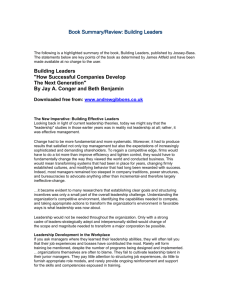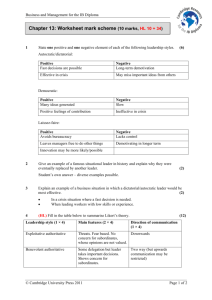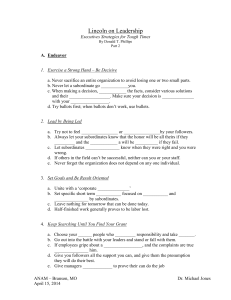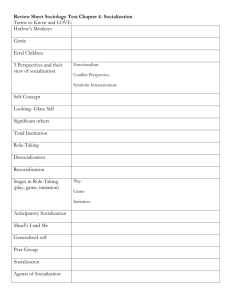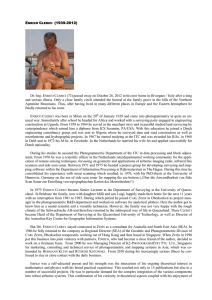Building Leaders How Successful Companies Develop
advertisement
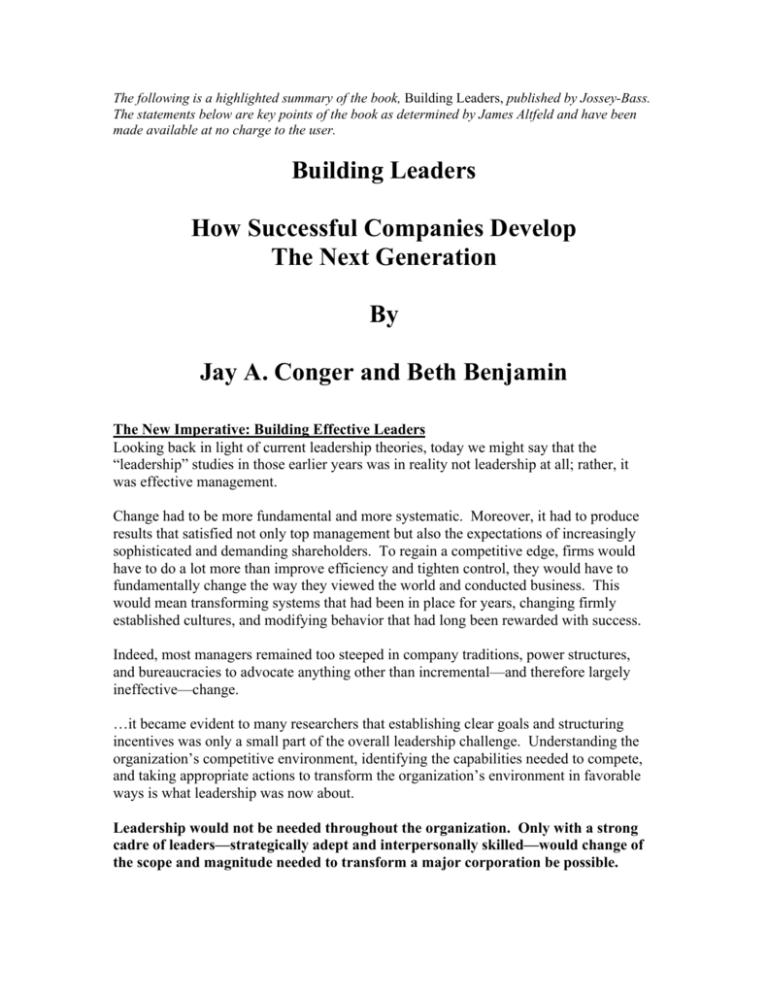
The following is a highlighted summary of the book, Building Leaders, published by Jossey-Bass. The statements below are key points of the book as determined by James Altfeld and have been made available at no charge to the user. Building Leaders How Successful Companies Develop The Next Generation By Jay A. Conger and Beth Benjamin The New Imperative: Building Effective Leaders Looking back in light of current leadership theories, today we might say that the “leadership” studies in those earlier years was in reality not leadership at all; rather, it was effective management. Change had to be more fundamental and more systematic. Moreover, it had to produce results that satisfied not only top management but also the expectations of increasingly sophisticated and demanding shareholders. To regain a competitive edge, firms would have to do a lot more than improve efficiency and tighten control, they would have to fundamentally change the way they viewed the world and conducted business. This would mean transforming systems that had been in place for years, changing firmly established cultures, and modifying behavior that had long been rewarded with success. Indeed, most managers remained too steeped in company traditions, power structures, and bureaucracies to advocate anything other than incremental—and therefore largely ineffective—change. …it became evident to many researchers that establishing clear goals and structuring incentives was only a small part of the overall leadership challenge. Understanding the organization’s competitive environment, identifying the capabilities needed to compete, and taking appropriate actions to transform the organization’s environment in favorable ways is what leadership was now about. Leadership would not be needed throughout the organization. Only with a strong cadre of leaders—strategically adept and interpersonally skilled—would change of the scope and magnitude needed to transform a major corporation be possible. Leadership Development in the Workplace If you ask managers where they learned their leadership abilities, they will often tell you that their job experiences and bosses have contributed the most. Rarely will form training be mentioned, despite the number of programs being designed and implemented. …organizations themselves are often to blame. They fail to cultivate leadership talent in their junior managers. They pay little attention to structuring job experiences, do little to furnish appropriate role models, and rarely provide ongoing reinforcement and support for the skills and competencies espoused in training. …individuals who truly want to develop and change the organization may ultimately leave in frustration. Certain individuals may possess leadership ability but simply choose not to exercise (Boyatzis, 1990). Some may prefer less demanding responsibilities and may wish to avoid the hardships that accompany leadership roles. Others may feel uncomfortable challenging the status quo and prefer to conform and be accepted rather than take risks and push limits (Loevinger, 1980). Center for Creative Leadership (CCL) The study confirmed that job assignments, bosses, and hardships did indeed play the most pivotal roles in executive development and therefore presumably in leadership development. The idea is that managers who work together on a challenging yet unfamiliar task will bring their individual experiences to bear, share, reflect, and learn. The approach is perhaps best exemplified by designs used at General Electric’s management development facility at Crotonville, New York. A typical GE program places developing managers in team-based experiential exercises aimed at solving real-life problems with immediate relevance to the company (Noel and Charan, 1988). Action learning programs also reflect another…management development: the shift from individual to team-based training. …leadership development has become more broadly defined. No longer does it apply on to an individual manager’s ability to lead but also to the development of a “leadership mind-set” for the entire organization. …new objectives for leadership education: • Creating dialogue, common vision, and shared commitments to facilitate effective organizational change • Orientation toward the bottom line • Imparting relevant knowledge that can be applied immediately • Building teams of leaders and leaders of teams • Disseminating leadership throughout the organization • • Providing mechanisms and opportunities for self-development Aligning management and support systems to promote and reinforce ongoing leadership development Developing the Individual Leader Because credibility and authenticity lie at the heart of leadership, determining and defining one’s own guiding beliefs and assumptions lie at the heart of becoming a good leader. By focusing on the individual, providing structured feedback, and prompting reflection, individual development programs can stimulate an important self-discovery process. …many of the best organizations we observed emphasized different facets of leadership for individuals at different levels of development or in different functions or domains. “There are some aspects of leadership that apply to everyone, regardless of rank…On the other hand, leadership in some ways is not the same for the sergeant as it is for the colonel…[There are] unique aspects of leadership that exist at the specific levels of leadership”. (Army Leadership, 1997, p. iii). Although the Army adheres to a single leadership framework across its entire military workforce, it recognizes that leadership progresses along a continuum of roles and responsibilities and requires different skills and abilities as the leader advances. How National Australia Bank Develops Leaders It was decided that the program should focus principally on three key dimensions of Leadership: contact, clarity, and impact. Contact refers to competencies that involve a leader’s ability to be in touch with themselves, their businesses, and their teams. Clarity has to do with the idea that leaders must be pathfinders who set new directions for their organizations and teams; they need to provide clarity about future goals and directions for their organization. Impact refers to whether the actions and ideas of the leader influence others. Under these three categories came ten core leadership behaviors and characteristics (see Exhibit 3.1). The emphasis, then, was primarily on helping individuals develop themselves as leaders. Exhibit 3.1. National Australia Bank Leadership Competencies 1. Impact Flexible and adaptable Committed to making a difference Communicates with impact A clear service orientation 2. Clarity Intellectually robust Constantly extends business knowledge Recognizes the imperative for change and creates new directions 3. Contact Strong self-regard Acts with integrity Brings out the best in people Reprinted with permission. 1. 2. 3. 4. a series of three self-directed learning exercises a one-day introductory seminar a six-day residential workshop a team-based learning project focused on understanding competitive issues facing the bank 5. a concluding seminar and 6. several follow-up initiatives in the form of an alumni network, executive feedback on the projects, and participant self-evaluations on behavior shifts over time. …participants received an assignment to be conducted on their own. …self-directed learning module …they were given an overview of the program, readings on leadership, a video on leadership, and the bank’s global strategic agenda. “We knew that most people here think of leadership as a ‘storm-the-hill’ activity—led from the front. We wanted them to think much more about it as a relationship between people and why leadership is so important to the National at this point in time.” The objective was to get the participants thinking more deeply about leadership and themselves. Participants were asked to consider the success factors for high-performing teams. The workshop was built around four learning goals: strategic issues facing the bank, leadership competencies, interpersonal relations, and teamwork. Participants learned the basics of team dynamics. How does my behavior shape how I influence others in teams? What patterns of my behavior come out under pressure? Are these valuable or a hindrance? Socializing Company Vision and Values Leaders inculcate these assumptions by building a shared understanding of what the organization is about and how it should operate. We often refer to this understanding as the organization’s culture. …most people follow the example of their leaders—adopting their values and imitating their management styles. Through an extensive socialization process, developing leaders learn and internalize the Army’s leadership creed through years of direct interaction with more experienced leaders. This interaction not only demonstrates consistency in values across levels of hierarchy and occupational specialties but also demonstrates a shared commitment to teaching and developing subordinates. Indeed, the training and professional development of officers is considered one of the most important responsibilities of all Army leaders (US Army, 1997, non-draft version). …clarifies and reinforces the Army’s vision and values along with the duties and expectations associated with carrying them out at each level of management. The Army maintains that through this integrated system it builds a common understanding of the character, attributes, and skills that its leaders are expected to possess and a shared dedication to the values and ethics that drive its culture and operations. The Importance of Socializing the Next Generation of Leaders A shared understanding of what the organization is about and where it is going to especially important in a world marked by rapid change and rising competition. In the socialization process, leaders play a dual role. One one hand they influence the socialization of all those below them, but on the other hand they too must be socialized to the organization’s vision and to their role in bringing the vision to fruition. …leaders, like other organizational participants, require socialization. Formalizing the Socialization Process Through Leadership Development In general, leaders work to achieve two basic objectives: to come up with the strategies or solutions needed to overcome organizational challenges and to implement those solutions efficiently and effectively. To improve implementation efforts, organizational leaders can systematically pay attention to important initiatives, measure and control outcomes associated with desired strategies, provide rewards and recognition to those who accomplish strategic goals, and role-model behavior consistent with chosen solutions. Of the firms we studies that recognized the importance of a strong vision and guiding philosophy, almost all recognized that leadership would be a dominant force in driving and sustaining their corporate visions through the rest of the organization. Because of the critical role that leaders would play in this process, these firms were extremely selective about the individuals they enlisted in their development efforts. In essence, participants were expected to be missionaries. …many of the Army’s leadership development programs are also highly selective, especially at the senior levels. For example, a Department of Army Selection Board determines who will attend senior officer training at the US Command and General Staff College. Among the most extensive selection processes we examined was Federal Express’s Leadership Evaluation and Awareness Process (LEAP). At Federal Express, leaders are expected to cultivate a “people-first” environment. The firm’s guiding philosophy is that “when people are placed first, they will provide the highest possible service, and profits will follow” (American Management Association, 1994) Once in a management role, they have the opportunity and responsibility to participate in the required and elective courses offered by the Leadership Institute. LEAP is a thorough evaluation process that involves multiple steps and requires participants to be evaluated by their supervisors, peers, and a formal assessment panel. The evaluation process (American Management Association, 1994) entails the following: • • • • • Attendance at an introductory on-day course entitles “Is management for me?” Compilation of an employee’s leadership profile. Formal assessment by the superior (the Manager’s Focused Recommendation). Formal assessment by peers. Formal evaluation by the LEAP Panel 1. Charismatic Leadership Charisma derives from the ability to see what is really important and to transmit a sense of mission to others. It is not exclusively the province of world-class leaders or a few generals or admirals. It is found in people throughout business organizations and is one of the elements that separates an ordinary manager from a true leader. Individuals who are charismatic leaders serve as symbols of success and accomplishment to others. They make others enthusiastic about assignments, command respect, and have a sense of purpose. Subordinates have faith in charismatic leaders and are proud to be associated with a leader whom they trust to overcome any obstacle. A charismatic leaders instills pride, faith, and respect among subordinates. 2. Individual Consideration Managers who practice the individualized consideration concept of transformational leadership treat each subordinate as an individual and serve as coaches and teachers through delegation and learning opportunities. They avoid treating subordinates alike. They discover what motivates each person individually and act on this discovery. These leaders have a “developmental” orientation toward followers and consciously or unconsciously serve as role models. They also show appreciation and give special attention to newcomers and those who appear neglected. 3. Intellectual Stimulation The importance of a leader’s technical expertise and intellectual power is frequently overlooked, particularly in high-performing organizations, because of the emphasis placed on interpersonal skills. However, intellectual stimulation is vital part of leadership that: • Arouses an awareness in subordinates of problems and of different methods by which to solve them • Provides compelling and convincing reasoning and evidence. • Stirs imaginations. • Promotes thought and insight prior to actions rather than immediate, emotionally stimulated reactions. 4. Courage Leaders stand up for unpopular ideas: they do not avoid confrontations by giving in to pressure. They are willing to give negative feedback to subordinates and superiors. A leader has confidence in his or her own capability, desires to act independently, and does the right thing for the company or subordinates in spite of personal hardships or sacrifice. 5. Dependability Leaders follow through and keep commitments, meeting deadlines, taking responsibility for actions, and admitting mistakes to superiors. Leaders work effectively with little or no contact with supervisors, but keep supervisors informed of progress. 6. Flexibility Leaders function effectively in a changing environment, provide stability, and remain objective when confronted with many responsibilities at once. Leaders handle several problems simultaneously, focusing on critical items. A leader changes course when required. 7. Integrity Leaders adhere to a code of business ethics and moral values, behaving consistently with the corporate climate and professional responsibility. A leader does not abuse management privilege, but gains trust/respect. A leader serves as a role model in support of corporate policies, professional ethics, and corporate culture. 8. Judgment A leader uses logical and intellectual discernment to reach sound and objective evaluations of alternative actions. Decisions are based on logical, factual information and consideration of human factors. A leader knows his or her own authority and is careful not to exceed it, and uses past experience and information to gain perspective on present choices. 9. Respect for Others A leader honors rather than belittles the opinions or work of others, regardless of their status or position in the organization. A leader demonstrates a belief in each individual’s value regardless of background, culture, or other similar factors. Organizational Needs Assessment, Tailored Content and Design Organizational analysis involves the assessment of the firm’s short- and long-term strategic goals, as well as the trends expected to affect those goals. “Area Effectiveness Survey” The survey asked partners to evaluate how effectively their area leaders communicated the firm’s vision to line partners and staff, involved others in planning and decision-making processes, and worked across organizational boundaries to align systems and eliminate barriers. It is crucial therefore for the success of any socialization program that the organization possess a vision and value set that are reasonably well articulated and lived out. In five-day sessions with nine high-potential junior executives, Enrico teaches about his personal philosophy of lending and the importance of building businesses as a core leadership competency. Crystallize Theories into Explicit Models, Attributes, and Behaviors Enrico distilled his leadership experiences into a model build around several major themes. Simple and to the point, five key themes were identified: 1. Think different terms: The central idea is that leaders must constantly be working on big ideas that provide a competitive edge for the organization in its future. Incremental changes are insufficient for long-term success. These continuous improvements are valuable, but thousands are required to drive the business. It is through “big changes to big things” that an organization builds the business. Moreover, effective leaders continually search for the big ideas. It is a continuous process. 2. Develop a point of view: Leaders must have a clear point of view. They are able to pinpoint and crystallize the opportunities into ideas. These ideas are, however, based on solid evidence and a belief in them is shared by important constituencies throughout the organization. 3. Take it on the road: Effective leaders sell their ideas throughout the organization to get buy-in. But before making the grand sell, they test market them on smaller groups of constituents who provide critical feedback and help in developing the initiative. Enrico likes to call this testing phase “going off Broadway before you go to Broadway.” This is also a time to test whether the language used to describe the idea evokes interest and passion. 4. Pull it all together: Once the idea is crystallized, the leader then must translate it into a clear vision, establish the right measurements, gain commitment from important stakeholders and effectively anticipate and deal with resistance. 5. Make it happen: Finally, leaders must communicate their vision using clear, vivid messages that both motivate and provide direction. This also involves identifying the key constituencies that need to support the initiative, enrolling them, and getting into place the processes and support systems that would give the efforts staying power. How FedEx and PepsiCo Socialize Vision and Values “At Federal Express, if you have the title of manager, that means you also have to be a leader…because all of our managers are responsible for people. You’ve got to listen to that voice [of leadership within]. It’s called common sense. It’s called conscience. It’s called the right thing. We at Federal Express have given you that special trust and confidence as a leader. We need to get this message out to company managers.” Servant Leadership Leaders work for their staffs, not the other way around. Case Study: PepsiCo’s Building the Business Program During the course of the program, each participant develops and refines a personal vision for their project, as well as an action plan for its implementation. Program Description That evening or the very next morning all participants must deliver an “elevator speech.” Enrico explains, “Imagine you have just gotten into an elevator. You have three minutes to the top. In that three-minute period, you need to convey the essence of your project and why it’s so important to the group who you are imagining in the elevator with you.” This exercise is used by Enrico to drive home the notion that unless an individual can articulate the essence of their project in less than three minutes then they need more work to crystallize their vision. Enrico’s message is straightforward: “This is how things get done. You don’t wait for somebody to tell you to do something. You don’t even have to wait for someone to tell you it is okay to do something. You figure it out and you make it happen. It is time to get your own agenda and to figure out how to drive it.” This is not a remedial course but a “take-it-to-the-next-level” course. His goal is to graduate a group of change agents who understand that the biggest value they bring is driving productive change. The purpose of the course is to give them some new ways to think about how to effectively drive change. Central to the learning experience is the opportunity to simply hear and learn from Enrico. Questions to him are an essential part of the learning. No question is off limits, and discussions are direct and candid. After this introduction, Enrico then focuses on how the division presidents describe “running their businesses” versus “building their businesses.” Running the business is the role of managing; building the business is the role of leadership. …”take back the streets” to emotionally convey the necessity of Frito overcoming its eroding market share. “Take back the streets” The final part of the program is devoted to lessons on how to make change happen. Strategic Leadership Initiatives Business leaders today face a marketplace characterized by change and growing complexity. Unfortunately, many leaders have discovered in the midst of this sea change that they are ill-prepared to respond to—let alone lead—this change. No longer will senior leaders be able to rely on the top-down command-and-control tactics of the past, for these work only when the organization’s environment is relatively stable and when directives can be well defined. Leaders throughout the organization—not just at the top—must be able to create strategy and lead change. …leadership development serves a dual purpose: it builds critical capabilities while at the same time achieving real-time business needs. According to Harvard Business School professor John Kotter (1996), the organization’s need to deal with its growing bureaucracy causes it to focus primarily on monitoring and managing internal operations rather than adapting to external demands. An emphasis on management—the set of processes that keeps existing systems running smoothly—rather than leadership—the set of processes that initiates and adapts the organization to significant change—becomes ingrained in the very fabric of the corporate cultures. …managers had become stronger in management skills than in leadership skills and that many had become overly confident and somewhat complacent. A New Role for Leadership Development …leadership development programs aimed at strategic intervention seek to advance five very different objectives: 1. 2. 3. 4. 5. To facilitate a unified, collective understanding of the firm’s strategic vision To expedite large-scale change To ensure the immediate application of useful knowledge To build depth of leadership talent To achieve measurable results that meet the “bottom line” Widespread involvement is a necessity. All managers and employees must take ownership of a new vision and apply it to their daily decision. In short, strategic thinking capabilities must be distributed throughout the corporate hierarchy. …it doesn’t take long to determine that hiring five faculty members or consultants to design and teach an in-company program for several hundred managers is less expensive than sending each of those managers to a one-week session at a prestigious university or commercial program. …leadership development programs that seek to facilitate strategic change have a number of common design elements. These elements include a well-articulated strategic framework, sophisticated assessment processes, content customized to promote strategic objectives, learning organized around executive cohorts, curricula designed to elicit collective dialogue, trained facilitators, and active feedback processes. 1. Strategic Framework Drives Program Content The single most important feature of any leadership development program designed to facilitate large-scale change is a clearly articulated framework that guides the firm’s collective efforts. 2. Up-Front Assessment of the Organization’s Learning Needs To be effective, strategic intervention programs must be preceded by an in-depth assessment of the organization’s learning needs. This ensures that program designs directly address critical obstacles and dilemmas facing the implementation of the firm’s strategic goals. 4. Curricula Designed to Elicit Collective Dialogue Between Units and Across levels Collective dialogue across functions and between levels is particularly important for developing a common understanding of a firm’s larger vision, and in turn a shared interpretation of how that vision can be adapted at the local level. 6. Active Feedback Mechanisms One program we studies was structured to allow extensive interaction between the organization’s new CEO and the top 140 or so leaders that make up its Senior Leadership Council. 3. Multiple Opportunities for Reflective Learning Feedback and reflection should be focused around the many different levels of learning that are occurring for the participant and their organization. In the betterdesigned programs, reflective learning opportunities are not only targeted at what was learned through the projects themselves but also on the person approaches and styles of the individual team members. Here are several topic areas for reflective learning that should not be overlooked: • • • • • • How do our findings confirm or disconfirm our existing notions of our marketplaces (competitors, customers, suppliers, governments)? Our existing notions of our organization and its capabilities and shortcomings? What am I learning as a participant about business strategy, leadership, organizational change, innovation, global markets, and so on? How effective are our group’s processes for accomplishing the project task? How effective am I as a team member in terms of my personal style, contributions, teamwork, initiative, decision-making approach, and so on. What am I learning about how other functions, business units, and the corporate center operate, and their distinct needs? (When the project is completed) What could we as a team and I as an individual have done differently to make the process more effective? How could I have improved my own contribution and performance within the team setting? The above summary has been provided to you compliments of Altfeld, Inc.
